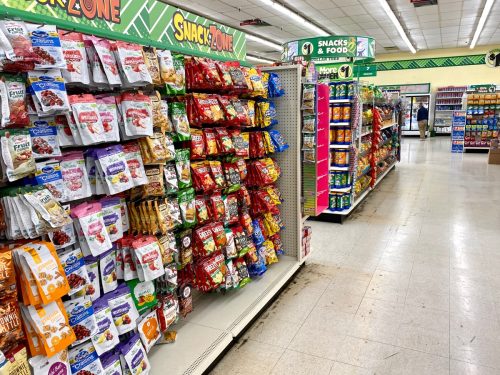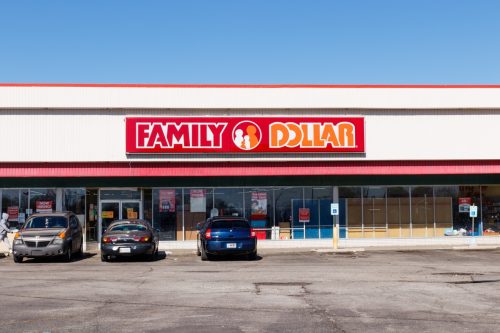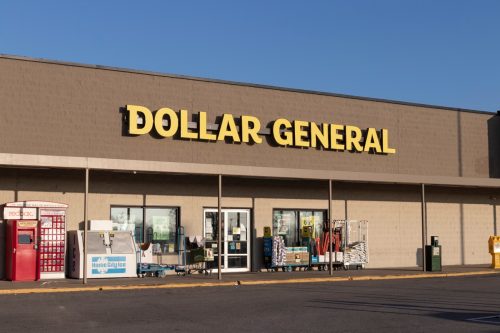These Dollar Store Chains Have Been Flagged for Dangerous Store Conditions
Several retailers have been cited by OSHA for hundreds of violations related to ongoing hazards.

Dollar stores have become ubiquitous within the U.S., spreading at a rapid rate over the past few years, with new locations popping up constantly. Last year, Dollar General Corp. and Dollar Tree, Inc. (which also owns the Family Dollar brand) beat out every other retailer in terms of growth—opening a combined total of more than 1,300 new stores across the three chains by the end of the 2022 fiscal year, per The Wall Street Journal.
Not everyone is happy about dollar store expansion, however. Some of these discount chains are being criticized for the potential harm they can have on communities, and they've been fined for overcharging shoppers in certain areas. But that's not the only downside dollar stores may carry. These retailers have also been flagged numerous times for dangerous store conditions that could put both customers and employees at risk. Read on to find out more about the latest citations.
READ THIS NEXT: Communities Are Fighting Back Against Dollar General and Dollar Tree—Here's Why.
Officials have called out dollar stores for potentially toxic products.

Back in Feb. 2022, the Campaign for Healthier Solutions and the Ecology Center Healthy Stuff lab released a joint-product screening report highlighting the presence of hazardous chemicals in items sold by some of the most popular dollar store chains in the U.S.
The researchers tested 226 products purchased from different Dollar Tree, Family Dollar, Dollar General, Five Below, and 99 Cents Only stores in several states and Canada. According to the report, 52 percent of the screened products tested positive for one or more chemicals of concern including lead.
"We should not have to wait this long for dollar stores to adopt safer chemicals policies," José Bravo, national coordinator of the Campaign for Healthier Solutions, said in a statement at the time. "Some chains like 99 Cents Only Stores and Five Below have so far shown little to no interest in adopting safer chemicals policies, while Dollar Tree is leading the discount retail sector and Dollar General continues to make slow progress."
But it's not just the products you buy that you should be worried about—the actual stores themselves could be putting you at risk. In recent years, three dollar store chains in the U.S. have been repeatedly cited by the U.S. Department of Labor's Occupational Safety and Health Administration (OSHA) for dangerous store conditions.
Dollar Tree has been accused of "endangering everyone" in its stores.

Dollar Tree is the latest chain to be cited by OSHA. In an April 24 press release, the agency said that the retailer is facing a total of $770,136 in proposed penalties for dangerous conditions found at two Rhode Island stores. The hazards discovered by inspectors included obstructed exits, unsafe storage, and blocked access to fire extinguishers.
But this is hardly the chain's first red flag. According to the release, OSHA has previously cited Dollar Tree for similar hazards at stores in Georgia, Idaho, Illinois, Massachusetts, Nebraska, New Jersey, New York, Rhode Island, Texas, and Wisconsin. Officials say these conditions not only create an unsafe workplace for employees, but that they also put shoppers at risk.
"In the event of an emergency, workers and others must have fast and safe access to unblocked exit routes," Eric S. Harbin, OSHA's regional administrator in Dallas, said in a February statement. "Retailers like Dollar Tree that fail to make sure their stores' storage areas are organized and safe are endangering everyone who works and shops there."
In a previous statement to Best Life, Dollar Tree spokesperson Kristin Tetreault said the company takes concerns like this "seriously" and immediately works to remediate the issues identified.
"At Dollar Tree we are focused on maintaining a safe environment for our associates and customers and ensuring our stores comply with all health and safety regulations," she said.
For more retail news delivered straight to your inbox, sign up for our daily newsletter.
Family Dollar has also been cited for dangerous store conditions.

Dollar Tree, Inc. isn't just facing fines for hazards found at Dollar Tree stores, however. The company has also racked up massive costs for dangerous store conditions flagged throughout the Family Dollar chain, which it acquired in 2015.
Back in Aug. 2022, it was hit with $1.2 million worth of penalties from OSHA after repeat violations were discovered at two Family Dollar locations in Ohio. Then in December, the agency tacked on another $364,645 in fines for the company when an inspection revealed four repeat violations at a Family Dollar in Georgia.
"Family Dollar and its parent company, Dollar Tree Stores Inc., continue to discount the safety of its employees and others for the sake of profits by unsafely storing merchandise," Jerred Stevens, OSHA acting area office director in Savannah, Georgia, said in a statement. "Time and time again, we find the company overfilling its storerooms and allowing merchandise to block aisles and emergency exits. This has to stop before someone is seriously hurt or unable to exit safely in an emergency."
Each new citation adds on to a "lengthy history" of safety violations for Dollar Tree, Inc., according to OSHA. Since 2017, the agency said both its federal and state-based programs have found more than 300 violations from over 500 inspections at Dollar Tree and Family Dollar stores throughout the country.
Tetreault previously told Best Life that the company takes issues that arise at Family Dollar stores "very seriously" as well. "Please know the safety of our associates and customers is our first priority," she said.
Dollar General has been deemed a "severe violator" for safety.

The Dollar Tree company certainly isn't alone when it comes to this long-standing problem. In the past five months alone, OSHA inspectors have uncovered concerning conditions at Dollar General stores in seven different states: Ohio, Florida, Alabama, Georgia, Pennsylvania, Texas, and Wisconsin. And that's just a part of the company's apparent history of hazards.
Since 2017, Dollar General Corp. has been hit with more than $16 million in fines and cited in over 180 inspections at stores nationwide for "numerous willful, repeat and serious workplace safety violations related to unsafe conditions," according to OSHA.
As a result, Dollar General recently became the first and only national retailer to be added to the Labor Department's "severe violator" list—which covers the companies that have failed to fix dangerous conditions despite receiving multiple citations.
"I am glad OSHA is not waiting for a tragedy to occur to document these hazards," Joseph McCartin, a labor historian at Georgetown University, told The New York Times in regards to Dollar General's severe violator addition. "But at the same time what is being revealed by the numerous OSHA inspections and mounting fees is that Dollar General doesn't care."
When asked in the past about its OSHA violations, Dollar General indicated that it was "committed to providing" a safe environment for its associates and customers.
"We regularly review and refine our safety programs, and reinforce them through training, ongoing communication, recognition and accountability," the company said in a prior statement to Best Life. "When we learn of situations where we have failed to live up to this commitment, we work to timely address the issue and ensure that the company's expectations regarding safety are clearly communicated, understood and implemented."
- Source: https://www.ecocenter.org/our-work/healthy-stuff-lab/reports/dollar-store-products-2022/press-release-toxic-chemicals-dollar
- Source: https://www.osha.gov/news/newsreleases/national/04242023
- Source: https://www.osha.gov/news/newsreleases/national/02232023
- Source: https://www.osha.gov/news/newsreleases/region5/08012022
- Source: https://www.osha.gov/news/newsreleases/region4/12022022
- Source: https://www.osha.gov/news/newsreleases/national/04202023





















